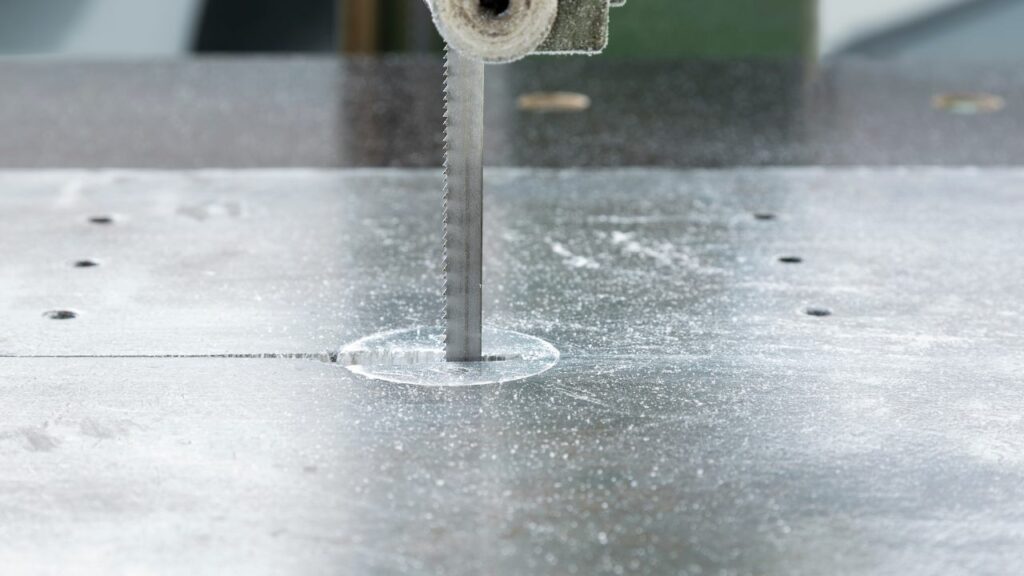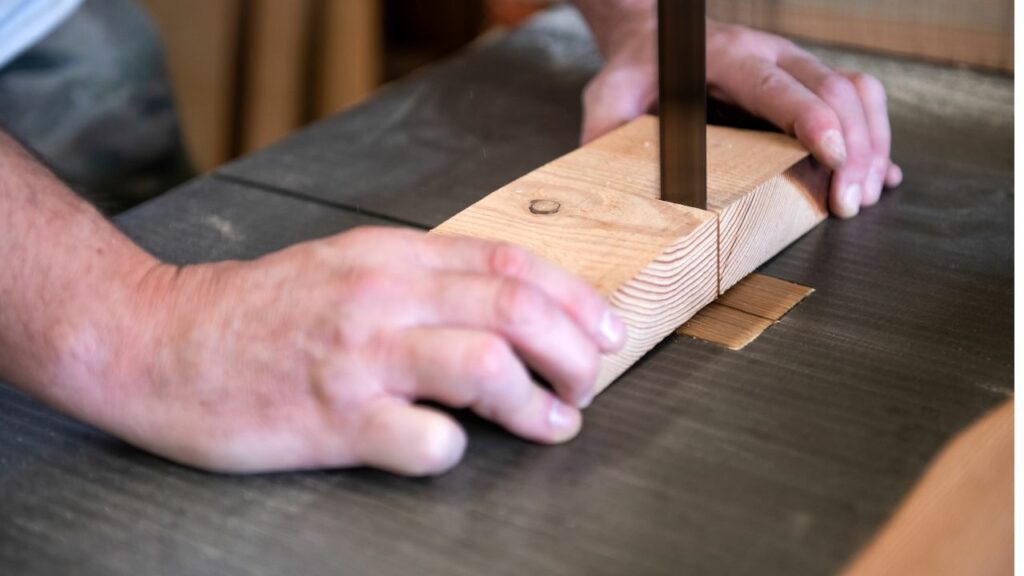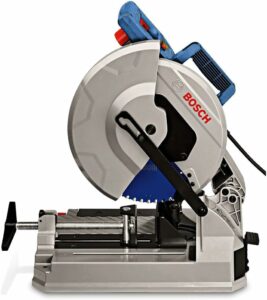Last Updated on December 1, 2023 by Pro Handyman Australia – Editorial Team
When choosing between different types of saws and different types of power saws, particularly a cold cut saw and a band saw, the distinction boils down to precision vs versatility. Cold saws and band saws each have unique advantages, making the choice between them dependent on your specific needs. However, if you find yourself debating between more common woodworking tools, the comparison of table saw vs miter saw or table saw vs mitre saw vs circular saw might also be of interest to you. Cold saws are known for delivering precise, clean cuts and having long-lasting blades, whereas band saws are appreciated for their versatility across different materials, even if they sometimes leave rough edges.
Understanding Saws: Mechanisms and Techniques
Distinguishing Cutting Capabilities
Cold saws and band saws each offer unique benefits. Band saws excel in versatility, handling diverse materials and sizes. However, they can sometimes produce uneven cuts with burrs on the edges. While their blades, having a limited lifespan, are non-reusable, many wonder if a circular saw blade can be sharpened. This query highlights the importance of maximizing the utility of saw blades across different saw types.
On the other hand, if you’re wondering what is a cold cut saw, it’s a tool that emphasizes precision, delivering cleaner and more accurate results. Though they may have a somewhat reduced cutting capacity relative to band saws, cold saws stand out with their rapid cutting speeds. One of the significant advantages of cold saws is their blade longevity; they can be sharpened and reused numerous times, presenting considerable cost advantages.
The Science of Milling vs. Cutting
Cold saws employ a milling technique powered by horsepower and torque, a contrast to the direct cutting method of band saws. Grasping milling requires a firm understanding of certain mechanics, such as speeds, feeds, and chip loads. The goal is to achieve the optimal chip load, and this hinges on two elements: the RPM (blade speed) and the tooth size. This balance becomes evident in material selection: while thin materials like ceramic tiles—where one might wonder how to cut ceramic tile without a wet saw—need finer-toothed blades for chip control, bulkier materials like solid bars necessitate coarser teeth to manage larger chips.
The Simplicity and Nuance of Band Saw Cutting
Band saws, in contrast to cold saws, offer a more straightforward cutting approach, much like the differences you’d find in a track saw vs table saw scenario. Generally, you can pick an appropriate blade and commence cutting with a band saw. Still, the blade choice is critical to ensure an effective cut, similar to how selecting the right saw – whether a track saw or a table saw – is crucial for specific tasks. If a band saw blade is incorrectly chosen, say with the wrong teeth per inch, it can negatively impact the cut quality. An evident sign of an inappropriate blade choice is the stripping of the teeth from the blade, a result of excessive chip load.

For the best results, it’s crucial to equip a band saw with a high-quality blade guide system. One of the essential band saw facts to remember is that this system involves carbide blade guides that secure the blade during the cutting process, ensuring straight cuts and preventing any misalignment or deviation
The Importance of Lubrication and Measurement
Lubrication stands out as a pivotal factor when it comes to optimizing the efficiency and quality of cuts made by cold saws and band saws. Not only does it enhance the cutting quality, but it also serves to keep the blade cool. This, in turn, extends the time between sharpening sessions, ensuring that your tool remains in top shape for longer.
Material measurement is equally crucial. While the act of cutting is a vital part of the process, setting up the part length and ensuring accurate measurements are indispensable steps. In many cases, one might find that they spend more time on measuring and aligning the material than on the cutting itself. This highlights the value of employing a measuring system. Whether you’re using a manual saw or a fully automated one, integrating a measuring system can reduce errors and significantly boost productivity.
Determining the Right Saw for Your Needs
Size and Cutting Capacity
Your specific application plays a vital role in dictating the best metal cutting options. If you’re contemplating how to cut straight with a circular saw, it’s essential to understand that the size of the material you plan to cut is a significant factor. A bandsaw typically offers a more extensive cutting capacity, whereas a cold saw might limit you in terms of size. For instance, a 14” cold saw might offer a capacity for 4 ¾” round material. In comparison, certain bandsaws might provide a capacity for up to 9” rounds.

It’s essential to understand the specifications: with cold saws, the specification is often based on blade diameter, not the actual cutting capacity. The blade hub and its radius can restrict the material size a cold saw can handle. In the case of bandsaws, the specification is gauged by the blade’s clearance to the head frame. A useful pointer to remember is that the model of a bandsaw can often hint at its round cutting capacity.
Material Hardness
The hardness of the material you’re cutting is another significant factor in choosing between a cold saw and a bandsaw. Cold saws come with certain limitations regarding material hardness. For example, cutting materials with a hardness above 42Rc can quickly dull the blade, especially since the blade’s hardness itself ranges between 60-63Rc.
Bandsaws, however, offer a broader range of configurations and teeth hardness options, making them more adaptable to cutting harder materials. But, it’s worth noting that despite their versatility, there are certain applications that neither saw type can manage, such as tasks requiring abrasive cutting.
The Kerf Factor
One essential aspect to consider when determining the economic viability of a job is the kerf – the width of the cut made by the saw blade. For those aiming to conserve material and thereby save money, understanding kerf differences between saws is crucial. Cold saws, known for their rigid blades, typically have a kerf ranging from 2.5 – 3 mm. In contrast, a bandsaw blade might have a kerf as slim as 42 thousandths of an inch. Over long stretches of material, this difference can translate into substantial savings. Cold saw blades, using a triple grind, ensure chip clearance, resulting in a kerf equivalent to the blade’s thickness. Bandsaw blades, with their wavy grind or offset tooth design, manage to keep the blade kerf minimal.

Prioritizing Finish
If achieving a premium finish is your priority, the cold saw emerges as the champion. It promises a remarkably square and precise cut that resembles a milled finish. This precision ensures tight miter joints and allows for cutting parts to the desired length, eliminating the need for secondary operations like re-facing or cleaning the cut surface.
Assessing Practicality and Cost-effectiveness
The age-old debate persists: which saw is more economical, the cold saw or the bandsaw? The answer isn’t straightforward, as it largely hinges on specific application requirements. Cold saw blades might have a heftier initial price tag compared to bandsaw blades, but one must consider their longevity due to the possibility of re-sharpening. In contrast, once a bandsaw blade wears out, it’s destined for disposal. While the re-sharpening attribute of cold saw blades can be a cost-effective advantage, it’s vital to ensure you’re not using a cold saw inappropriately to cut corners. This could result in higher long-term costs due to the need for replacements.
User Experience: Real Hands-on Insights
As the debate between the cold cut saw and the band saw continues, firsthand experiences from professionals offer invaluable insights.
Bosch 305mm 12″ GCD 12 JL Cold Cut Drop Saw

John, a seasoned woodworker, recently shared his experience after trying out the Bosch 305mm 12″ GCD 12 JL Cold Cut Drop Saw. “The cuts were incredibly clean,” he remarked, “and it’s evident that the Bosch 305mm 12″ GCD 12 JL Cold Cut Drop Saw lives up to its name.”
Baumr-AG PBS20 Band Saw

On the other side, Maria, a metal artist, preferred the Baumr-AG PBS20 band saw. She noted, “It’s versatile and the cutting capacity meets all my artistic needs. I’ve managed to achieve intricate designs seamlessly with the Baumr-AG PBS20.”
Such feedback is invaluable, and by delving into hands-on experiences, one can truly appreciate the unique strengths of each tool based on practical application.
Comparisons: A Closer Look at Top Models
When it comes to cold cut saws and band saws, a comprehensive comparison can help elucidate the finer points of each tool. Consider the following table:
| Model | Type | Power (Watts) | Longevity (Hours) | Price ($) |
|---|---|---|---|---|
| Bosch 305mm 12″ GCD 12 JL | Cold Cut Saw | 1500 | 500 | 350 |
| Baumr-AG PBS20 | Band Saw | 1300 | 650 | 320 |
| KANG Industrial CS-9 | Cold Cut Saw | 1550 | 520 | 370 |
| Kingtech | Band Saw | 1250 | 600 | 300 |
While the Bosch 305mm 12″ GCD 12 JL and KANG Industrial CS-9 offer greater power, the band saw models boast longer operational hours. It’s crucial to determine which factors are most significant for your projects.
Conclusion
In the end, the choice between a cold saw, a bandsaw, or even the best circular saw boils down to specific needs and applications. Both tools have their unique strengths and potential cost benefits. What’s most important is to find the right fit for your particular requirements. And rest assured, regardless of your choice, there are quality models available to deliver the expected results. If you’re in Brisbane and need assistance with such tools or any other household tasks, consider reaching out to Brisbane Handyman Services. They are known for their expertise and can guide you further.
